You Can’t Control the Weather
BARROW, ALASKA– Just after the last dispatch, a strong wind storm settled in across the Arctic north of the Alaskan coast. For five days in a row we woke up hoping the wind would subside enough to allow us to fly for bear recaptures, only to find the wind remained steady at 25-40 knots through every day. The temperature rose again, staying mostly in the mid-twenties (Fahrenheit), but the windchill made trips out onto weatherdecks bitterly cold. Fortunately for most of the storm we were hove to in ice, keeping us out of large swells. We were within 30 miles of a bear that was a top priority for recapture, and weather was likely just as poor near other bears, so it simply became a waiting game.
One afternoon a young adult female polar bear wandered by the ship. She appeared out of the blowing snow and walked past the stern, fairly close to the ship. An hour later she reappeared and approached the ship, walking up the fantail until she was directly below the railing. Scientists and personnel from the ship were pressed at the railing above, and she just seemed to be curious, sniffing the wind and looking back at us, occasionally pawing the broken ice at the ship’s waterline.
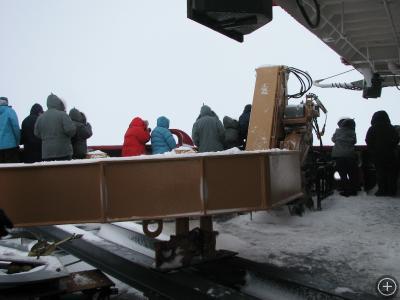
The railing of the fantail where folks are standing is about 5 meters, 15 feet, above the ice where the bear was standing, at the aft end of the ship, the fantail. It was a wonderful chance for people to see this bear up close.
The wind finally dropped below 20 knots for a day and we flew for the bear – only to encounter heavy fog that prevented us from finding her. We located another bear that was a lower priority and we successfully captured her, yielding good data. The next day the fog dissipated and we flew for our priority bear again, but she had moved over 30 miles and we could not locate her until we received a satellite transmission at the end of the day. We remained in the area because this bear was one of the two top priority recaptures remaining, and we successfully located her twice, but both times she was traveling in large areas of broken ice which were unsafe for captures. The temperatures remained warm throughout this period, rarely dropping below 25 degrees; the water temperature remained warm as well, and sea ice simply was not forming very fast.
This is a frustrating aspect of field work: success relies heavily on weather, and the bad luck of encountering stretches of poor weather can put an entire field season on hold. The only thing that can be done is planning. We planned a long field season to provide multiple opportunities to recapture each bear, and we planned on capturing secondary target bears as necessary. Thus, even though strong winds and fog really reduced our flight opportunities and poor ice reduced our capture opportunities, we had successful recaptures of target bears and we were able to process new bears as well.
The poor ice conditions we have encountered are remarkable. Air and water temperatures remained very warm throughout October, slowing the formation of new ice as winter begins. The current distribution of sea ice in the Beaufort is much more typical of late summer than early winter – we have not had to break heavy ice at all in the last 10 days. It is inaccurate to state that this warm October has been caused by climate change; climate refers to long-term patterns of average conditions, not day-to-day weather. Even in a world with an enhanced greenhouse gas effect, some autumns will be colder than normal and others will be warmer than normal. However, climate change is changing what is considered “normal.” As the earth’s climate warms, particularly in the Arctic, the type of weather we are experiencing may become common.
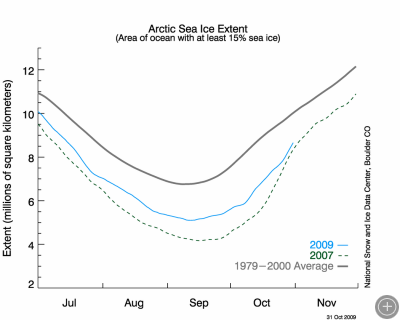
Graph from National Snow and Ice Data Center. Extent of sea ice over the entire Arctic is currently low compared to the 1979-2000 average, in fact, it is nearly as low as the same date in 2007, when the extent fell to a record low.
Today we disembarked from the ship, using helicopters to ferry people and luggage back into Barrow. Although the trip ended on a frustrating note, overall, it was a very exciting success. Every piece of data we gathered is unique – almost nothing is known about polar bears during this time of year, particularly bears out here on the pack ice far out at sea. I cannot wait to return to Laramie and receive data from our shore-based capture crew, which recaptured bears on the coast during the last several weeks. Before any in-depth analyses, it will be informative simply to compare data sets from the bears on ice to the bears on the coast, to see if differences are striking.


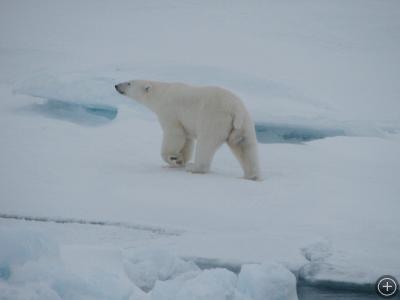
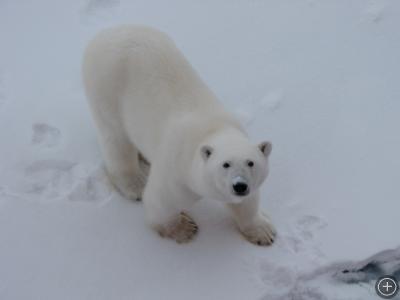
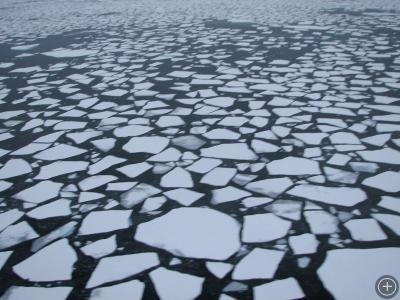

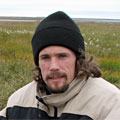







Fantastic photos!!!! I was in Barrow in the 80s, working as a waitress at The Top of the World restaurant. I wonder how much it has changed, besides the weather.
My daughter is a crewmember onboard Polar Sea…..one of the Marine Science Technicians. I know she was very excited to be a part of this mission and we’ve been thrilled with your updates and pictures. Thank you very much.
Howdy,
Thanks for reading. We had a long-time resident of Barrow on the cruise; he noted that it has grown a fair amount in recent years, and there is a strong emphasis in the community to retain traditions that otherwise may be fading away.
The MSTs were great – they really helped the lab work and technical operations go smoothly. I sure appreciated their help.
Thanks,
John